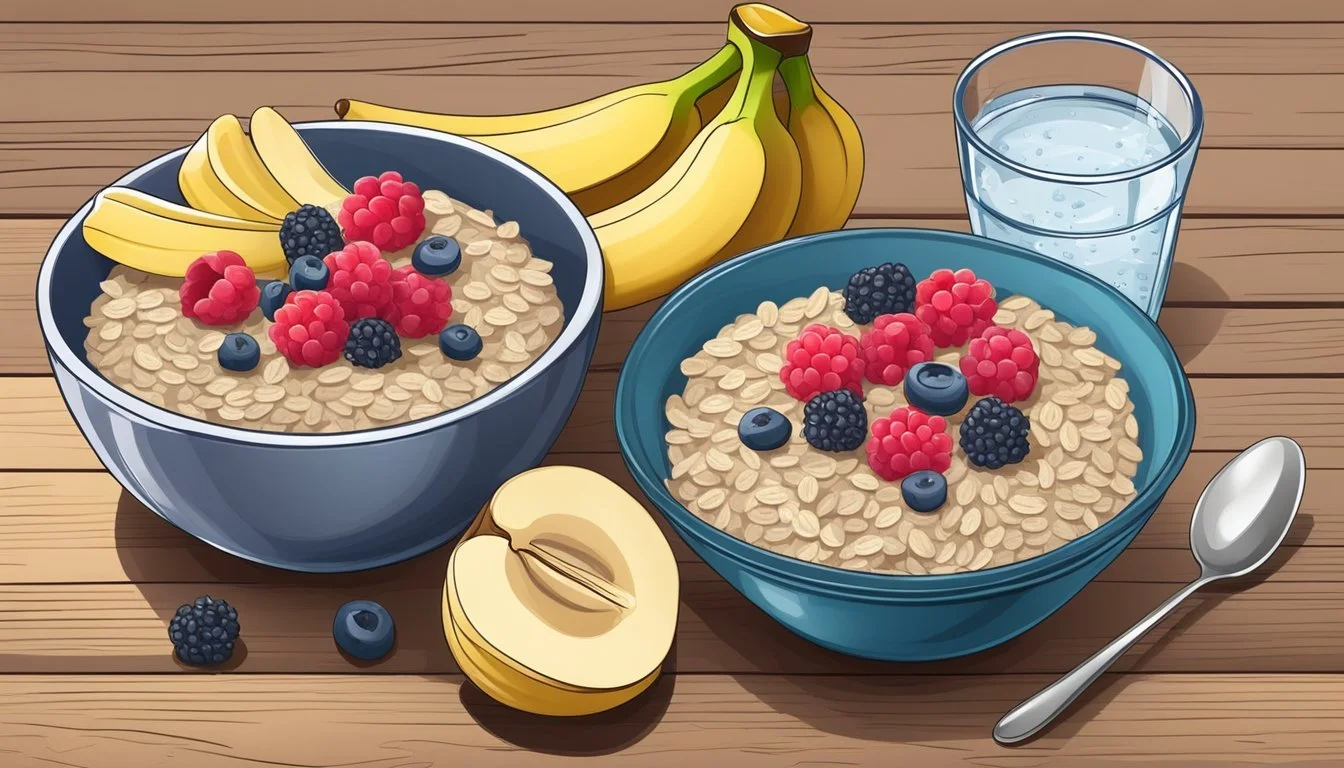22 High-Fiber Foods You Should Eat for Better Health
Essential for Digestive Health and Wellness
Dietary fiber is an essential component of a healthy diet, providing significant benefits for digestion, weight management, and overall well-being. Found mainly in fruits, vegetables, grains, and legumes, fiber is crucial for maintaining a healthy digestive system and can significantly aid in preventing chronic diseases.
Understanding which foods are high in fiber and incorporating them into daily meals can help enhance one's health and vitality. Fiber-rich foods not only support digestive health but also contribute to lowering cholesterol levels, stabilizing blood sugar, and promoting a feeling of fullness, which can help with weight control.
1) Chia Seeds
Chia seeds are a notable source of dietary fiber, making them an excellent inclusion in fiber-rich diets. One ounce (28 grams) of chia seeds contains approximately 11 grams of fiber. This significant fiber content helps promote digestive health and can aid in regular bowel movements.
In addition to fiber, chia seeds are rich in omega-3 fatty acids, protein, and antioxidants. The combination of these nutrients supports overall cardiovascular health. Studies suggest that the high fiber content may help lower blood pressure and reduce inflammation markers.
Chia seeds are versatile and easy to incorporate into various dishes. They can be sprinkled on oatmeal, mixed into yogurt, or added to smoothies. Their small size and neutral flavor allow them to blend seamlessly into many recipes without altering the taste.
The fiber in chia seeds can also provide a sense of fullness, assisting in weight management. This is particularly beneficial for those looking to control their appetite. Moreover, the fiber helps regulate blood sugar levels, which is important for individuals managing diabetes.
2) Lentils
Lentils are an excellent source of dietary fiber. Just half a cup of cooked lentils provides around 9 grams of fiber. This contributes significantly to the recommended daily intake.
Rich in both soluble and insoluble fiber, lentils support regular bowel movements and help maintain gut health.
In addition to fiber, lentils are packed with protein, providing about 12 grams per half-cup serving.
Lentils also deliver important vitamins and minerals. Notable nutrients include potassium, zinc, copper, manganese, iron, and phosphorus. This combination makes lentils a highly nutritious food choice.
The low-fat content in lentils, only about 0.5 grams per serving, makes them an ideal option for those looking to reduce fat intake while maintaining nutrient density.
Lentils can be easily incorporated into various dishes like soups, salads, and stews. They are versatile and adapt well to different cuisines, adding both flavor and nutritional value.
3) Black Beans
Black beans are a powerhouse of nutrition, especially known for their high fiber content. A serving of cooked black beans (1/2 cup) contains 7 grams of fiber. This makes them an excellent choice for those looking to increase their fiber intake for better digestive health.
In addition to fiber, black beans are packed with essential nutrients. They provide a significant amount of folate, iron, and potassium. Folate is crucial for producing red blood cells, while iron is necessary for oxygen transport in the blood.
Black beans also contribute to heart health. Their high fiber content helps in lowering cholesterol levels. Furthermore, black beans contain plant compounds and antioxidants, which may offer additional benefits for overall health.
Incorporating black beans into the diet is simple and versatile. They can be added to salads, soups, stews, and even as a side dish. Their mild flavor allows them to blend well with various recipes, making them a staple in many cuisines.
These legumes are also an excellent source of plant-based protein. For vegetarians and vegans, black beans offer an important protein alternative to meat. Their protein content supports muscle repair and growth, making them beneficial for everyone.
4) Oatmeal
Oatmeal is a highly nutritious food known for its high fiber content. It is particularly rich in soluble fiber, specifically beta-glucan, which is beneficial for heart health by helping to lower cholesterol levels.
One serving of oatmeal usually provides around 4 grams of fiber.
Oatmeal can be easily incorporated into breakfast routines. It can be topped with fruits like berries, which are also high in fiber. Adding nuts such as almonds can further increase the fiber content of the meal.
Oatmeal also has the advantage of promoting feelings of fullness and reducing appetite. This makes it a valuable addition to any diet, particularly for those looking to manage their weight.
While oatmeal's fiber benefits are numerous, some individuals may experience mild digestive issues, such as gas or bloating, when increasing their fiber intake.
Despite this, the health benefits of oatmeal make it a popular choice for anyone aiming to boost their dietary fiber intake.
5) Artichokes
Artichokes offer a low-calorie, nutrient-rich option for those seeking to increase their fiber intake. One medium-sized artichoke provides approximately 6.9 grams of fiber, making it a valuable addition to a high-fiber diet.
Beyond fiber, artichokes are also a good source of vitamins and minerals. They are particularly high in vitamin C, folate, magnesium, and potassium. These nutrients support various bodily functions, contributing to overall health.
The inclusion of artichokes in meals can support digestive health and help individuals meet their daily nutrient requirements. With their versatility, they can be incorporated into a variety of dishes, from salads to main courses.
Artichoke extract is another option, often used in supplements for its potential health benefits. Like the whole vegetable, the extract is rich in antioxidants and supports various aspects of health.
When preparing artichokes, they can be steamed, boiled, grilled, or added to soups and stews. This allows for a range of culinary possibilities, making it easy to enjoy their health benefits in different ways.
Artichokes provide a flavorful and nutritious option for enhancing fiber intake and supporting a balanced diet.
6) Raspberries
Raspberries are a standout when it comes to fiber-rich foods. A single cup of red raspberries provides an impressive 8 grams of fiber. This makes them one of the highest whole food sources of fiber available.
Besides their high fiber content, raspberries are low in calories, with just 64 calories per cup. They also contain 14.7 grams of carbohydrates, 1.5 grams of protein, and 0.8 grams of fat per serving.
Their rich nutrient profile extends beyond fiber. Raspberries are packed with vitamins and minerals like vitamin C, manganese, and antioxidants. These nutrients contribute to overall health and can support immune function and reduce inflammation.
Raspberries can be easily incorporated into a variety of dishes. They work well in breakfast bowls, smoothies, salads, and desserts. Adding a cup of raspberries to oatmeal or yogurt not only boosts fiber intake but also adds natural sweetness and a burst of flavor.
With their versatile uses and high nutritional value, raspberries are an excellent choice for anyone looking to increase their fiber intake while enjoying a delicious and healthy fruit.
7) Quinoa
Quinoa is a highly nutritious grain known for its impressive fiber content. A cooked cup (185 grams) of quinoa provides about 5.18 grams of fiber. This makes quinoa a valuable addition to a fiber-rich diet.
Compared to other grains, quinoa has a unique nutrient profile. Along with fiber, it offers significant amounts of protein, making it a complete protein source. It also contains essential vitamins and minerals such as manganese, folate, zinc, iron, phosphorus, magnesium, and vitamin B1.
The fiber in quinoa aids digestion and helps maintain regular bowel movements. Furthermore, its low glycemic index can help control blood sugar levels, potentially assisting in the prevention of type 2 diabetes.
Another benefit is its versatility in cooking. Quinoa can be used in salads, soups, or as a side dish, providing a healthy and tasty alternative to traditional grains like rice or pasta. This adaptability makes it a popular choice for those seeking to increase their fiber intake.
Incorporating quinoa into meals can contribute to satiety, helping individuals feel fuller for longer periods. This satiety is beneficial for weight management and overall health.
8) Split Peas
Split peas, derived from the Pisum sativum plant, are a nutritional powerhouse. They are excellent sources of both soluble and insoluble fiber.
A 3.5-ounce serving of cooked split peas offers 21.1 grams of carbohydrates, which includes 8.3 grams of fiber. This high fiber content aids in maintaining digestive health and can help regulate blood sugar levels.
Additionally, split peas provide substantial plant-based protein. A 196-gram cup serving contains 16 grams of protein, making them a valuable addition to vegetarian and vegan diets.
These legumes are low in fat and calories. A half-cup portion delivers about 130 calories and is virtually fat-free, which is beneficial for those mindful of caloric intake.
Split peas are rich in essential minerals like magnesium, phosphorus, and potassium. They also offer significant amounts of vitamins B6 and K, contributing to overall well-being.
Foods rich in complex carbohydrates like split peas can provide sustained energy levels. This makes them a smart choice for those looking to maintain a stable energy supply throughout the day.
Including split peas in meals can be a simple yet effective way to boost daily fiber and nutrient intake. They can be easily incorporated into soups, stews, and salads.
9) Pears
Pears are a nutritious fruit rich in dietary fiber. One medium-sized pear provides approximately 5.5 grams of fiber, making it a valuable addition to a high-fiber diet.
Pears are also low in calories. A mid-sized pear contains around 100 calories, making it a healthy snack option that helps maintain fullness due to its fiber content.
Due to their fiber and water content, pears support weight management by promoting a feeling of fullness. This can be beneficial for those looking to manage their weight without excessive calorie intake.
10) Broccoli
Broccoli is a nutrient powerhouse, rich in fiber, vitamins, and minerals. This green vegetable contains significant amounts of fiber, making it an excellent addition to any diet focused on digestive health and regularity.
One cup of cooked broccoli offers approximately 6 grams of fiber. Both soluble and insoluble fibers are present, contributing to improved digestion and reduced cholesterol levels.
Besides fiber, broccoli provides an impressive array of vitamins, including vitamin C, vitamin K, and several B vitamins. It's also a good source of iron and potassium.
You can enjoy broccoli in numerous ways. Steaming is a particularly good method to preserve its nutritional value. Broccoli can be added to soups, salads, stir-fries, or enjoyed raw with a dip.
Incorporating broccoli into meals is a simple and effective way to boost overall fiber intake. Its versatility in meal preparation makes it a favorite for many looking to enhance their diet with high-fiber foods.
Benefits Of High-Fibre Foods
High-fibre foods offer numerous advantages, including improved digestive health, assistance in weight management, and a reduced risk of heart disease. These benefits are grounded in medical research and supported by dietary guidelines.
Digestive Health
Dietary fiber is crucial for maintaining optimal digestive function. It increases the weight and softness of stool, making it easier to pass and reducing the likelihood of constipation. Fiber also helps solidify loose stools by absorbing water, which can alleviate diarrhea.
Fiber supports the growth of beneficial gut bacteria, enhancing overall gut health. Fermentable fibers, such as those in fruits and legumes, act as prebiotics, feeding the probiotics in the digestive tract and fostering a balanced microbiome.
Weight Management
High-fibre foods can play a significant role in weight management. Fiber-rich foods are generally more filling, which can help reduce overall calorie intake by promoting feelings of fullness, thus preventing overeating.
Fibers like those found in whole grains, vegetables, and fruits take longer to chew and digest, contributing to a lower caloric absorption. Soluble fibers can also slow the digestion of carbohydrates, providing a steady release of energy and reducing hunger.
Heart Health Benefits
Consuming high-fiber foods can contribute to better heart health. Dietary fiber helps lower LDL cholesterol levels by binding to cholesterol particles in the digestive system and removing them from the body, which can reduce the risk of coronary artery disease.
Fiber also aids in regulating blood pressure and reducing inflammation, further mitigating the risk of cardiovascular issues. A diet high in fiber from sources like oats, beans, and flaxseeds is particularly beneficial for maintaining heart health.
How To Incorporate High-Fibre Foods Into Your Diet
Incorporating high-fiber foods into your diet can significantly improve digestive health and help maintain a healthy weight. This section covers practical tips for meal planning, snacking, and cooking that will help you increase your fiber intake effectively.
Meal Planning Tips
Start your day with whole grain cereals or oatmeal. These options are rich in fiber and can be easily paired with fruits.
For lunch and dinner, focus on including legumes like beans, lentils, and chickpeas. Add them to salads, soups, and stews.
Incorporate a variety of vegetables in every meal. Aim for different colors to ensure a range of nutrients. Spinach, broccoli, and carrots are excellent choices.
Use whole grain alternatives for bread, pasta, and rice. These retain more fiber compared to refined grains.
Snacking Strategies
Choose snacks that are naturally high in fiber. Fresh fruits like apples, berries, and oranges are convenient and nutritious.
Vegetable sticks such as carrots, celery, and bell peppers make for crunchy, fiber-rich snacks. Pair them with hummus for added flavor.
Nuts and seeds are excellent for on-the-go snacking. Almonds, chia seeds, and flaxseeds provide a healthy dose of fiber and healthy fats.
Consider incorporating dried fruits like apricots, figs, and prunes, but be mindful of portion sizes as they are calorie-dense.
Cooking Techniques
Opt for steaming or roasting vegetables to maintain their fiber content. Avoid overcooking, which can reduce the fiber and nutrient levels.
Incorporate fiber-rich ingredients like flaxseeds or chia seeds into baked goods such as muffins, bread, and granola bars.
Use beans and lentils as meat substitutes in various dishes. They are versatile and can be used in burgers, stews, and casseroles.
Experiment with adding whole grains like quinoa, bulgur, or barley to your salads and soups. These grains are easy to cook and enhance fiber intake.
By following these guidelines, you can effectively boost your fiber intake and enjoy a variety of health benefits.




